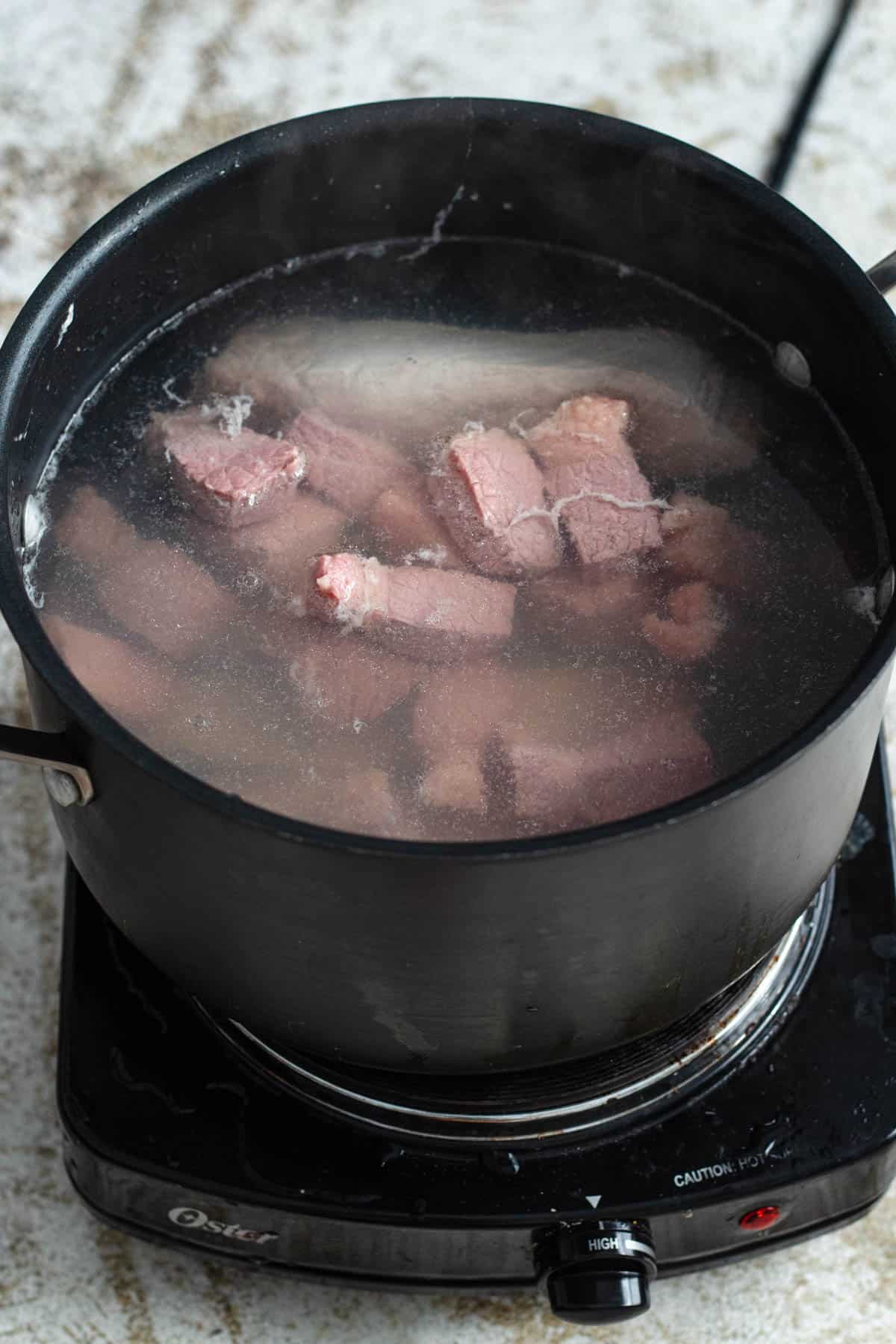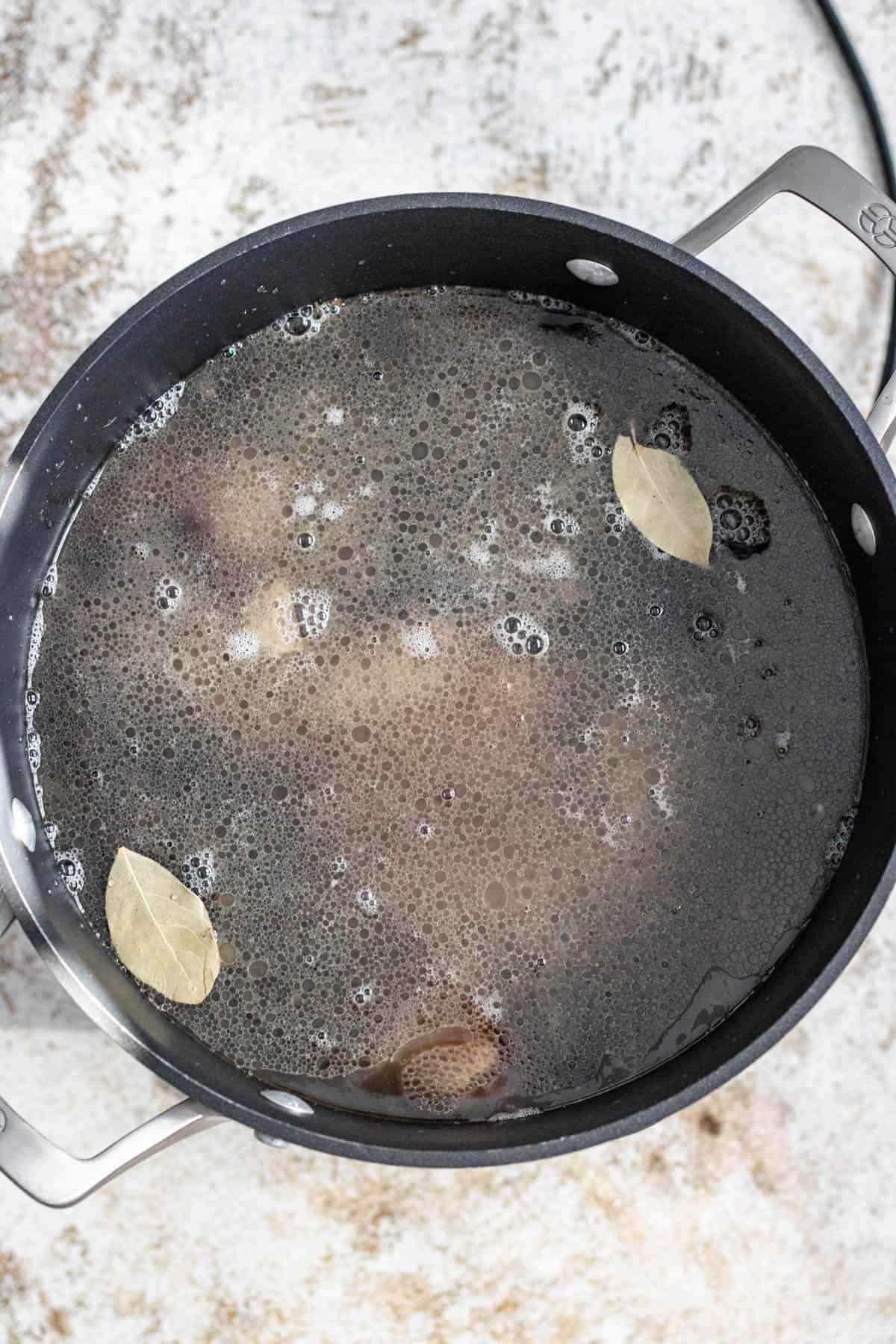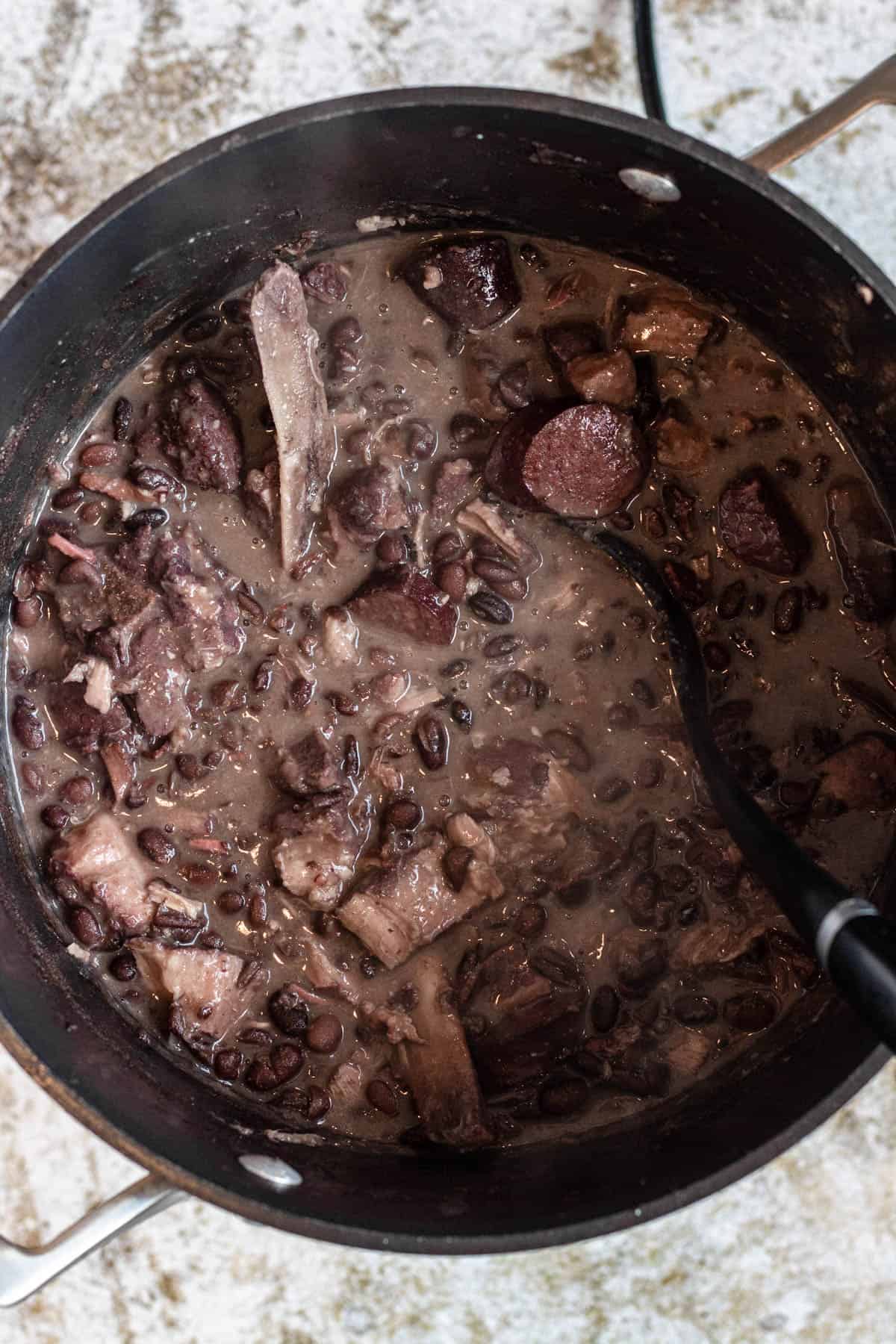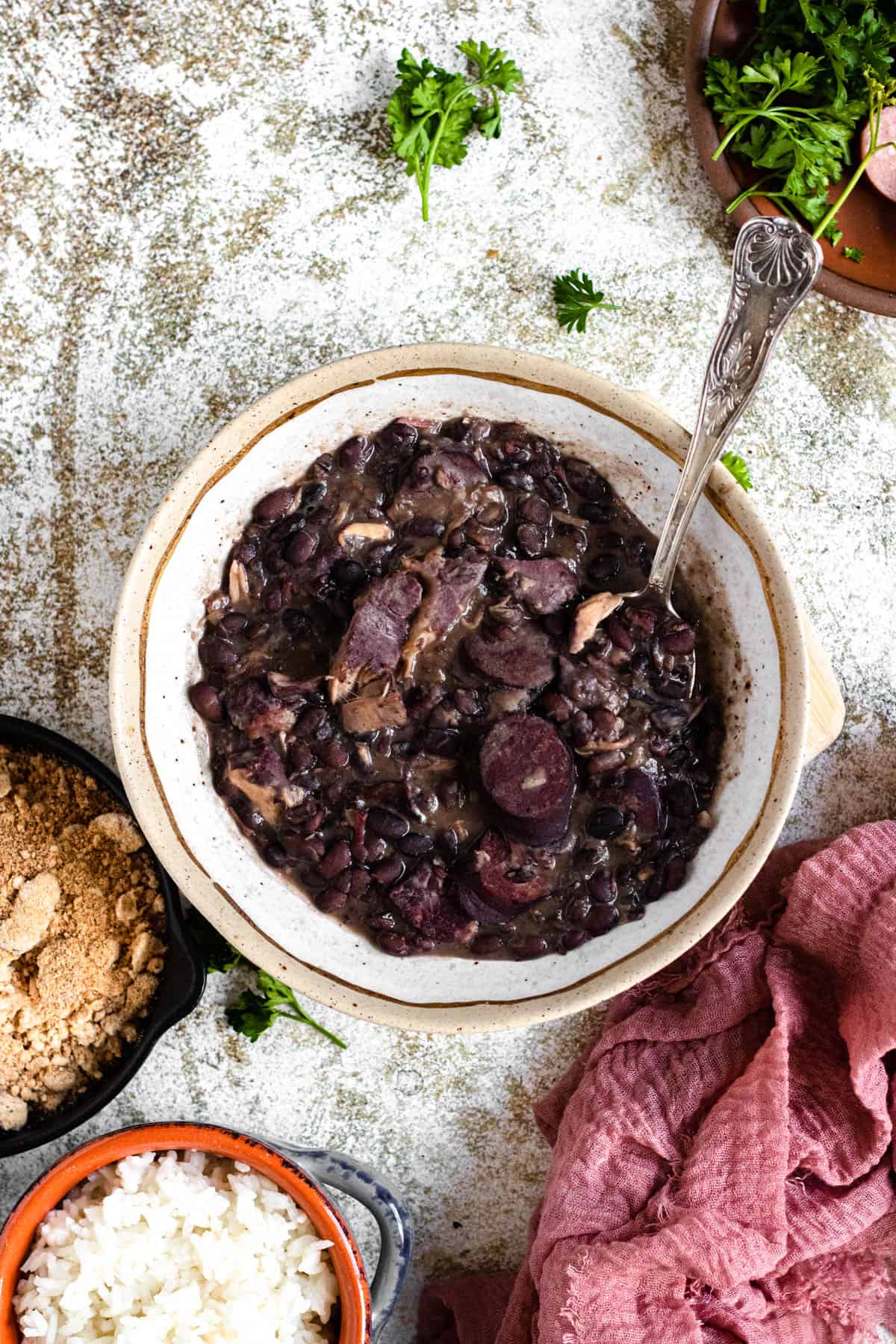Feijoada is a thick, rich black bean stew, stuffed with several different kinds of pork and beef. The result is a dish that is delicious, warm, and comforting. It’s also the national dish of Brazil and a recipe worth sampling!

Hello Reader! I try my hardest to research recipes as best as I can before posting to ensure I am representing each culture correctly. If this recipe is from your country and I have made a mistake or you have suggestions for how to make it more authentic, I would love to hear! Please leave a comment below letting me know what should be different, and I will rework the recipe. It is always my intention to pay homage and respect to each cultural dish that I cook. Thanks for reading!
Brazilian Cuisine is known for bringing together inspiration from many different cultures and regions including European, Indigenous, Italian and African flavors. The result is always something uniquely delicious.
One dish that can be found in every part of Brazil, from the poorest home to the nicest restaurant is Feijoada. It’s a delectable, thick Brazilian black bean stew made with several different kinds of beef and pork.
Like most good dishes, every home cook who makes this meat stew has their own version. Some are thick, while others have more of a saucy, soupy texture.
What binds them all is the combination of tasty meats–mainly pork and beef.
Traditionally feijoada has been made with pig’s ears, pork shoulder, feet and snout, along with sausage and smoked or salted beef (similar to this Cassava Leaf from Libya!). Any part of the pig or cow that was not used for another meal was thrown into this dish. Some Brazilians say it has everything from the pig but the oink.
While this may not sound appetizing at first, it’s really the combination of all those flavors that makes this dish so irresistible.
My recipe makes this dish a little more accessible to the average American. I don’t expect you to go out and purchase pig ears. Instead, my recipe calls for a variety of main ingredients you can easily find at the grocery store. It may not be a perfectly traditional feijoada recipe but it is equally delicious.
What has made this recipe so enduringly popular is in addition to being incredibly delicious, it’s also very easy and affordable to make. It’s the perfect dish for a weeknight meal or to warm you up on a cold day. It’s also a great dish to feed the whole family.
If you are looking for a new dish to try for dinner this week–add this one to the list!
Recipe Origin
Feijoada gets its name from the Portuguese word for beans “feijão”. This is because Feijoada is a stew made with black beans and multiple kinds of meat. The ingredients in this recipe cook on the stove for hours, creating a unique, black-colored stew that tastes rich and is full of protein.
Feijoada can be made with almost any pork or beef cuts you have on hand, but the traditional options are Carne Seca (here substituted with corned beef), pork ribs, bacon, and sausage. Traditionally, the stew was also made with the cheaper cuts of meat, including pigs’ feet, beef tongue, pigs’ tails and more.
Most believe that Feijoada originated from the slaves that worked the sugar cane plantations in Portugal. The slaves would take the undesired cuts of meat that were left over from the slave owners’ dinners and use those cuts of meat to make this hearty stew.
Some scholars, however, doubt this story, as pigs’ feet and tails were considered delicacies at the time and were popular in many European stews. Based on this, it is also possible that the enslaved people made this recipe for the slave owners to eat.
Today Feijoada is a dish beloved by everyone in Brazil. It is commonly eaten with Farofa (a toasted cassava flour side dish), orange slices, white rice, and collard greens on the side.
Why Make This Recipe?
- Plenty of Protein: Everyone needs protein to help build muscle, and this dish is chock full of it! It can be a challenge to find meals that offer a good amount of protein but with black beans and the myriad of meat in the stew, this dish delivers.
- Easy: There is some prep that goes into getting the best flavor and texture from your meat, but this dish is all cooked in one pot and can be left to boil for over an hour. You could even throw it in a slow cooker.
- Taste of Brazil: There is a reason this dish is Brazil’s national dish. It’s full of flavor and easy to customize. If you can’t take a trip to Brazil you can still bring a bit of Brazil to your home with this recipe!
What Do I Need To Make This Recipe?
Ingredients

- Corned Beef: This is a substitution for the traditional Carne Seca, as Carne Seca is almost impossible to find in America. You will need to de-salt your corned beef (detailed in the instructions below). You can also use beef jerky as a substitute if desired.
- Pork Ribs
- Smoked Sausage: Use Lingüiça sausages if you can find it, or kielbasa!
- Chorizo Sausages: Chorizo is the closest substitution for Brazilian sausage. If absolutely necessary, you can also use andouille sausage. I was not able to find chorizo on the day of photographing this recipe, so I subbed andouille sausage (pictured above).
- Thick Cut Smoked Bacon: Cut into pieces
- Dry Black Beans: Soaked in water overnight and rinsed
- Flavoring/Spices: White onions, garlic, salt, pepper, bay leaves
Tools
- One Large Pot
How to Make This Recipe
[adthrive-in-post-video-player video-id=”ez9grg5n” upload-date=”2023-03-30T03:28:03.000Z” name=”Feijoada Recipe” description=”Feijoada is a thick, rich black bean stew, stuffed with several different kinds of pork and beef. The result is a dish that is delicious, warm and comforting. It’s also the national dish of Brazil and a recipe worth sampling!” player-type=”default” override-embed=”default”]
Step One: Prepare your Ingredients

Start your Feijoada recipe the night before by soaking the black beans in a large bowl of water overnight. The next day, drain the black beans and rinse them until the water runs clear.
Trim the large layer of fat off the top of the corned beef, leaving a small fat cap. Cut the corned beef into 1” slices and put it in a large bowl. Rinse it under cold water 2-3 times to remove a lot of the salt. Then fill the bowl with cold water and allow it to soak for another 10 minutes. Once soaked and desalted, cut the corned beef into cubes.
Bring a large pot of water to a boil and add in the pork ribs and the corned beef. Boil for 10 minutes, scooping the foam off the top. This removes the remaining salt from the meat.
Remove the meat from the water, rinse, and set aside.
Step Two: Assemble the Stew


In a large pot, add the bacon, chorizo, and smoked sausage over medium-high heat until the bacon has released its grease. Continue cooking until the sausage and bacon are crispy.
Then add the garlic and chopped onions into the pot with the bacon, and saute until the onions soften and the garlic smells fragrant.
Add the boiled meat into the pot with the bacon and onions.
Step Three: Let it Simmer



Add the soaked and drained black beans and bay leaf. Then fill the pot with enough cups of water to just cover the ingredients. Do not add any salt at this point. Cook on low heat for about 1 ½ hours until the beans are soft. Remove the lid and cook for another half an hour.
After two total hours of cooking, remove about 1 cup of beans from the stew and place them in a small bowl. Mash the beans until they break apart and then add them back into the pot. Mix to combine.
Continue cooking, uncovered, for another 30 or so minutes, until the stew has thickened enough to coat the back of a spoon. If your stew is not thickening, remove another ½ cup of beans at a time to mash and add back into the stew.
Once the feijoada recipe is done cooking, add salt and black pepper to taste. Serve and enjoy!
Recipe reviewed by Camilla Hurst from piesandtacos.com
Expert Tips

- The corned beef is a replacement for Carne Seca, which is a salted meat popular in Brazil. It is almost impossible to find in the USA, so corned beef is a good alternative.
- This dish is usually served with farofa, a toasted cassava flour side dish popular in Brazil.
- Chorizo can be a bit greasy. You may want to drain some of the grease after cooking the bacon and chorizo before adding in your onions.
- In some parts of Brazil, feijoada is made with a few more vegetables in the stew. Feel free to experiment with any veggies you like.
FAQs

Feijoada is traditionally served with rice and a side of orange slices or orange wedges and collard greens. It is also accompanied by farofa, which soaks up the bacon or butter flavor it is cooked in and provides a lovely crunch.
Brazilians may also eat feijoada with hot sauce and fried plantains.
Feijoada is a heavy meal that is often eaten at a time when it can be savored and not rushed. Brazilian restaurants may serve feijoada on Wednesday afternoons during an extended lunch period or on Saturdays and Sundays.
It’s the perfect meal for gathering and slowly enjoying with family and friends and is a recipe that is enjoyed by all social classes, rich or poor.
You could use canned black beans for this recipe but dry beans will produce the best flavor and texture for the dish.
I recommend soaking beans overnight to help make them tender and ready to be cooked the next day. This step helps prevent the beans from splitting during cooking.
I use dried beans because this stew needs to cook long and slow to get the best texture for the meat. If you use canned beans your dish will still be delicious but your beans may become very soft and you may end up with a thicker dish overall as more of your beans lose their shape and turn mushy.
The simple answer is yes. This meal would be great for cooking in a pressure cooker, instant pot or slow cooker. Simply prepare your meat and sautee your onions as mentioned above and then cook to your liking.
I have not attempted making this dish with this method so I can’t say exactly the perfect cooking time.
Yes, Brazilian feijoada is a great freezer meal. You can cook up a large batch and save smaller portions in an airtight container in the freezer for several months. Heat each serving in the microwave or on the stovetop with a bit of water.
Did you enjoy this recipe for Feijoada (Black Bean Stew) from Brazil? If so, make sure to check out these other recipes I picked out just for you:
- Acai Bowl from Brazil
- Brigadeiro Recipe (Chocolate Fudge Balls) from Brazil
- Lima Beans and Corn Succotash
- Instant Pot Cuban Black Beans
- Black Bean Cakes from Antigua

Feijoada (Black Bean Stew) from Brazil
Equipment
- Pot(s)
- Mixing Bowl(s)
Ingredients
- 1 lb Black beans, dry, soaked in water overnight and rinsed
- 1 lb Corned beef
- 2 lb bone-in Pork Ribs
- ½ lb Thick Cut Smoked bacon, cut into pieces
- ½ lb Chorizo sausages, cut into ½” diagonal pieces
- ½ lb smoked sausage, like Lingüiça sausages or kielbasa, cut into ½” diagonal pieces
- 6 cloves Garlic, sliced
- 2 White Onions, diced
- 2 Bay leaves
- Water
- Salt, to taste
- black pepper (Use code FF20 for 20% off), to taste
Instructions
- Start the night before by soaking 1 lb black beans in a large bowl of water overnight. The next day, drain the black beans and rinse them until the water runs clear.
- Trim the large layer of fat off the top of a pound of corned beef, leaving a small fat cap. Cut the corned beef into 1” slices and put it in a large bowl. Rinse it under cold water 2-3 times to remove a lot of the salt. Then fill the bowl with cold water and allow it to soak for another 10 minutes. Once soaked and desalted, cut the corned beef into cubes.
- Bring a large pot of water to a boil and add in 2 lbs pork ribs and the corned beef. Boil for 10 minutes, scooping the foam off the top. This removes the remaining salt from the meat.
- Remove the meat from the water, rinse, and set aside.
- In a large pot, add the ½ lb bacon, ½ lb chorizo sausage, & ½ lb smoked sausage over medium-high heat until the bacon has released its grease. Continue cooking until the sausage and bacon are crispy.
- Then add the 6 garlic cloves and 2 chopped onions into the pot with the bacon, and saute until the onions soften and the garlic smells fragrant.
- Add the boiled meat into the pot with the bacon and onions.
- Add the soaked and rinsed beans and 2 bay leaves. Then fill the pot with enough water to just cover the ingredients. Do not add any salt at this point. Cook on low heat for about 1 ½ hours until the beans are soft. Remove the lid and cook for another half an hour.
- After two total hours of cooking, remove about 1 cup of beans from the stew and place them in a small bowl. Mash the beans until they break apart and then add them back into the pot. Mix to combine.
- Continue cooking, uncovered, for another 30 or so minutes, until the stew has thickened enough to coat the back of a spoon. If your stew is not thickening, remove another ½ cup of beans at a time to mash and add back into the stew.
- Once the feijoada is done cooking, add salt and pepper to taste. Serve and enjoy!
Notes
- Corned Beef: This is a substitution for the traditional Carne Seca, as Carne Seca is almost impossible to find in America. You will need to de-salt your corned beef (detailed in the instructions below). You can also use beef jerky as a substitute if desired.
- Pork Ribs
- Smoked Sausage: Use Lingüiça sausages if you can find it, or kielbasa!
- Chorizo Sausages: Chorizo is the closest substitution for Brazilian sausage. If absolutely necessary, you can also use andouille sausage. I was not able to find chorizo on the day of photographing this recipe, so I subbed andouille sausage (pictured above).
- Thick Cut Smoked Bacon: Cut into pieces
- Dry Black Beans: Soaked in water overnight and rinsed
- Flavoring/Spices: White onions, garlic, salt, pepper, bay leaves
- The corned beef is a replacement for Carne Seca, which is a salted meat popular in Brazil. It is almost impossible to find in the USA, so corned beef is a good alternative.
- This dish is usually served with farofa, a toasted cassava flour side dish popular in Brazil.
- Chorizo can be a bit greasy. You may want to drain some of the grease after cooking the bacon and chorizo before adding in your onions.
- In some parts of Brazil, feijoada is made with a few more vegetables in the stew.
- Feel free to experiment with any veggies you like.










Thomas McCay says
I love black beans and will hang on to this recipe and make it when I can get out of bed again. Recovering from an accident.
I love what you do and frequently visit your blog.
Alexandria Drzazgowski says
Hi Thomas, I’m so sorry to hear about your accident. I hope you recover quickly! Thank you for the kind words on my blog, I am so happy to hear that you enjoy visiting it 🙂 I can’t wait to hear what you think of this Feijoada when you are feeling well again!